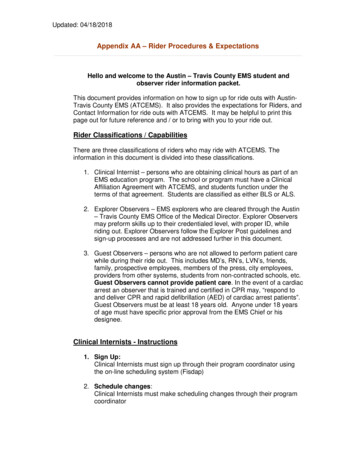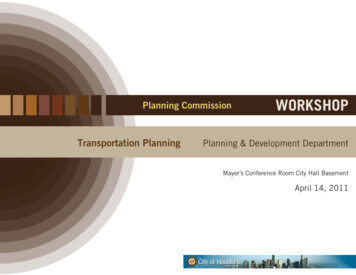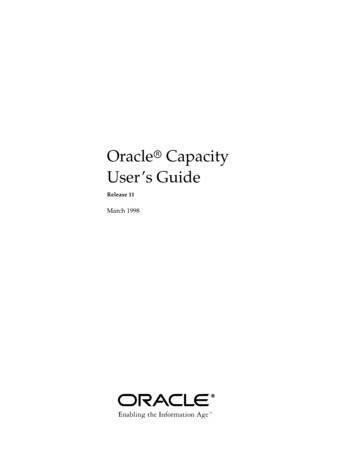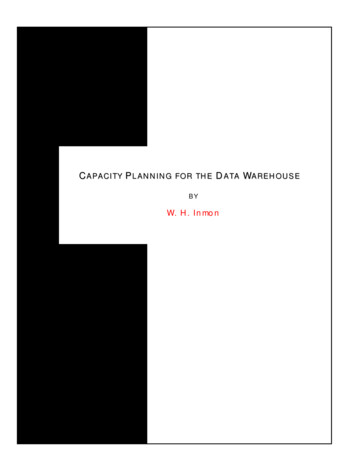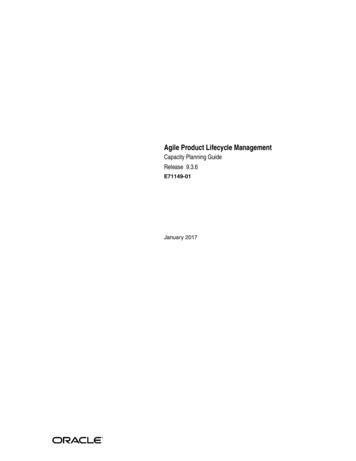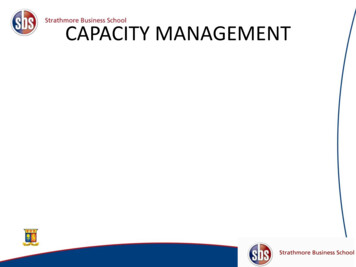
Transcription
STATION CAPACITY PLANNING GUIDANCENetwork RailNovember 2016
CONTENTS1THE OVERVIEW . 52UNDERTAKING CAPACITY ASSESSMENTS . .1Identifying the need for an assessment . 7Remits . 7Proposals . 8Demand forecasts . 8Data requirement and collection . 9SPACE REQUIREMENTS FOR NORMAL OPERATION . 10Passenger demand concepts . 10Revenue protection . 12Platforms . 16Canopies . 20Concourses . 22Access and interchange . 25PLANNING FOR ABNORMAL CONDITIONS . 34Perturbation . 34Construction . 36Special events . 36Emergency evacuation. 36STATION PERFORMANCE CATEGORISATION . 39Station performance categorisation . 39
November 2016ForewordWith significant investment plannedfor stations across the network, it isimportant that the industry adopts aconsistent approach to the planningand design of our stations.Network Rail Station Capacity Planning GuidanceIn the past decade, the number of railpassengers has grown by 50 percent andstations like London Waterloo and LondonVictoria now handle more people per daythan the UK’s busiest airports. However, untilrecent years, there has not been any newmajor infrastructure and many of our stationsare busier than ever.Since Victorian times, our railway hasn’t justmoved passengers and freight; it hasgenerated, and spread, prosperity. That iswhy we are continuously investing in ournetwork with several high profile schemessuch as Thameslink, Crossrail, EdinburghGlasgow Improvement Programme andNorthern Hub. Station upgrades and newfacilities will play a key role in deliveringthese schemes and helping to increasecapacity, safety and passenger comfort. Theimportance of stations in delivering a betterrailway is clearer than ever.With significant investment plans for stationsacross the nation, it is important that theindustry adopts a consistent approach forplanning and design of station environments.This document provides a series of bestpractice guidelines for the design andplanning of railway stations to guarantee thatwe continue to deliver value for money andexcellent passenger experience across thenetwork.Isabelle MilfordStation Capacity ManagerModern stations are the shop windows of ourrailway. In addition to providing access totrain services our stations are used asmeeting places and provide opportunities forretail and leisure. Passengers expect, anddeserve, a positive experience at stations aspart of their overall journey on the railway.Ease of access, readily available travelinformation and ambient station space willimprove passenger satisfaction and theattractiveness of rail as a mode.3
November 2016Executive SummaryThis document provides guidancefor undertaking capacityassessments for stations acrossthe network. It stipulates thethresholds for planning and designof passenger areas with aconsideration for ‘value for money’.Network Rail Station Capacity Planning GuidanceThe guidance shall be used by all partiesinvolved in the station design processincluding, but not exclusive to, Network Railstaff, architects, train operating companies(TOC) and engineering and planningconsultants.This document supersedes the previousversion published in May 2011. The guidancewill be periodically updated to reflect ongoingresearch, consultation and changes inlegislation and shall be read in conjunctionwith;The application of this guidance ensuresstation design supports the Industry andNetwork Rail’s objectives, namely: Station Design Principles for Network RailGuide, March 2015 Develop and maintain consistently highperforming stations that support safemovement of passengers and customersatisfaction Deliver station improvements anddesigns that are fit for purpose, costeffective and sustainable.This guidance provides the informationrequired by architects and designers toproduce an outline station design focussingon public areas. It includes all calculationsrequired to assess whether a station meetsNetwork Rail’s aspirations regardingpassenger comfort and safety in the stationenvironments, during normal operations andemergency/perturbation situations. Spaces and Places for Everyone, NetworkRail Inclusive Design Strategy, 2015 Design Standards for Accessible RailwayStations, Department for Transport andTransport Scotland, March 2015 Other Rail Industry Standards andBuilding codes referred to in Appendix FQueries or comments regarding thisdocument are welcomed and should be sentto: stationcapacity@networkrail.co.uk.It also provides a good practice guide forundertaking capacity assessments. Thisinformation is relevant for those responsiblefor station capacity assessment studies andcontains the Network Rail requirements withregards to analysis and deliverables.4
November 20161 The OverviewIntroduction to the basicprinciples of spatial planning forpublic areas and Network Rail’splanning criteria.Network Rail Station Capacity Planning GuidanceThis guidance applies to the spatial aspectsof station planning for public areas duringnormal operations and abnormal conditions.Requirements for staff accommodation andareas that are only used by tenants are notcovered in this guidance.It is important to understand that the capacityrequirements included here shall be treatedas a minimum. Depending on the projectaspirations it may be desirable to deliberatelydesign public areas in excess of the spatialrequirements outlined here.The following chapters provide methods forsizing public areas that have sufficient spaceto allow unimpeded circulation ofpassengers, and also for reasonable comfortin waiting areas.The Fruin levels of Service (LoS) specifiedhere relate to Network Rail’s aspirations ofproviding adequate level of comfort withoutmaking stations uneconomically large. Theseguidelines are applicable to existing and newstations. Station layouts shall always beassessed in relation to the peak usage that iseither based on a survey or predicted futuredemand.5
November 2016Network Rail Station Capacity Planning GuidancePassengers have different needs and behavedifferently within any given stationenvironment (see Figure 1-2). They walk atdifferent speeds on flat and steppedsurfaces. For example, most passengerswalk at speeds between 0.6 to 2.0m/s on flatsurfaces in free-flow conditions. An averageadult may walk at a speed of 1.5m/s or aboveon flat surfaces in normal conditions1. Incrowded conditions however, the walkspeeds are significantly lower.Passenger demand shall be classified intothe following categories. Analysts shallconsider site specific factors that may affectpassenger demand and diversity e.g.availability of step-free access, stationsconnecting to airports or stations nearhospitals. Such assumptions shall be agreedwith the Network Rail’s Station CapacityTeam (NR SCT).Commuters are normally travelling to andfrom work or place of study and are familiarwith the station layout and train services. Atmost stations, a large proportion ofpassengers during the peak periods areregular commuters.1The passenger walk speeds quoted here are based onLeisure travellers are infrequent users ofthe railway; may require assistance in termsof wayfinding and train information. Theygenerally tend to arrive at the station earlier,and hence dwell longer in comparison withregular commuters. At some stations, a largeproportion of users can be of this type on aFriday afternoon and at weekends or duringspecial events. They may also carry someform of luggage.Passengers in wheelchairs need step freeaccess and may require assistance inaccessing train services or other facilities at astation.Passengers with reduced mobility mayhave a physical or cognitive condition whichaffects their ability to navigate within a stationenvironment. Such passengers require morespace, time or even staff assistance.Passengers with luggage require morespace depending upon the size and shape ofluggage they are carrying. This includespassengers carrying small rucksacks, largeshopping bags, large musical instruments,regular or fold-up bikes and large suitcases.Passengers with young children andinfants in pushchairs may be slow-movingand prefer to remain in groups.anecdotal evidence gathered from various stations on theNational Rail network. These are consistent with thepassenger walk speeds observed by Transport for London atLondon Underground stations.6
November 20162 Undertaking CapacityAssessmentsGuidance for analysts and otherparties involved in scoping andproducing capacityassessments studies.Network Rail Station Capacity Planning Guidance Evaluate the impact on passengers dueto changes in timetables, introduction ofnew services or rolling stock2.1 Identifying the need for anassessmentStation capacity assessments shall beundertaken for the design and planning of allnew railway stations and for schemes thataffect the usage and flow of passengers instation environments. For any scheme,consideration shall be given to the stationlayout, volume of passengers and complexityof movement, GRIP (Governance for RailwayInvestment Projects) stage and the level ofintervention. Particular consideration shall begiven to station category2, strategicimportance along the Route or within thelocal area.NR SCT shall be consulted at the earliestopportunity in order to identify the need of anassessment and to help define a remit.2.2 RemitsA remit shall clearly set out the following withrespect to the assessment that is required: Context, the strategic fit and the problemstatement Objectives of the study3, scope,interdependenciesThe objectives of an assessment maytypically include: Indicates any gaps in availability ofpassenger and train information Benchmark existing station performance Operational and other assumptions Optimise station layouts Option selection and designdevelopment Evidence for a business case Test crowd management, constructionimpact and evacuation plans Programme milestones and deadlines.Remits shall be developed by the Client,Sponsor or Manager in conjunction with, orreviewed by, the NR SCT. Following on fromthis, a proposal will be provided by the NRSCT or an external consultant.32Better Rail Stations, November 2009.Clearly set out what is expected from the assessment i.e.what are the questions that need answering.7
November 2016Network Rail Station Capacity Planning Guidance2.3 Proposals2.4 Demand forecastsThe NR SCT or an external consultant shallrespond to the remit with a project proposal.This proposal shall be sent to the Client,Sponsor or Manager and reviewed by the NRSCT.A vast majority of station users are railpassengers, but some stations also offer avariety of retail, attracting a significantnumber of visitors who are not rail users.Some stations may also provide access toother transport modes, such as trams ormetro services. A station may also generatefootfall by offering a short-cut between twoexternal locations and hence it may benecessary to include such non-railbackground demand; e.g. the new concourseat Birmingham New Street station connecttwo sides of the city centre.It is important that respondents understandthe objectives and various stages of anassessment to develop a comprehensiveproposal.Each proposal shall demonstrate: Good understanding of the remit, thecontext, ability to identify key areas thatneed to be analysed and anyconstraints. Strong capability in the discipline andselection of an appropriate method foranalysis based on site complexity. Detailed cost and resource breakdowndemonstrating value for money. Project plan showing alignment withwider NR delivery programme. Allowance for review and feedback fromNR SCT throughout the project.Capacity assessments shall at least consideran interim and future year scenario. Anyprofiling of passenger demand across thepeak in relation to train loadings shall beagreed with NR SCT.Network Rail Economic Planners can providedemand forecasts based on Route Studiesand other forecasting tools used in theindustry. Forecasts developed by aconsultant or another organisation will needagreement with the Network Rail EconomicPlanners at the start of any assessmentproject.The Client, Sponsor or Manager will approveand initiate an assessment project once theNR SCT has completed a technical andcapability review of the proposals.8
November 2016Network Rail Station Capacity Planning Guidance2.5 Data requirement and collection2.5.1 Passenger and train dataWherever possible, surveys shall becommissioned to establish a goodunderstanding of passenger numbers in andaround stations and any station specificcharacteristics in relation to train services,interchange and operational controls. Datarequirements may vary based on the scopeof the assessment and project objectives.A survey shall cover two morning andafternoon weekday peaks (e.g. 0700 – 1000and 1600 to 1900hrs) and any other timeswhen passenger volumes are known to behigh. Validation counts and observationsshall be made to ensure consistency in thedata that is collected. At some stations it maybe necessary to include other times duringweekdays and weekends depending on theproject objectives and station usage.Network Rail Project Managers shall reviewthe checklist in Appendix A, to identify if therequired data is readily available and startsourcing this information from Network Railstudies, train operating companies, LocalAuthorities, Transport for London, Merseyrailor other third party developers.Any gaps in the data shall be clearly definedin the remit. In all cases, NR SCT shall beconsulted to determine the suitability of usingexisting data. Appendix A includes a briefdescription of the different datasets requiredand suggested methods of data collection.NR SCT can organise surveys if required.Where surveys are being commissioned byconsultants the proposed methodology andscope will require approval from the NR SCTand the Station Manager. It is important thatcareful consideration is given to the planningand safe operations during any survey.For new stations, demand data may comefrom forecasting models and the suitability ofsuch forecasts and underlying assumptionsshall be discussed with the NR SCT.2.5.2 Station layout and operationsAll assessments require an accuratedefinition of the physical layout of the stationbeing assessed; typically this informationshall be in electronic CAD format.The configuration of existing infrastructuresuch as escalators, ticket barriers and stationentry gates shall be observed and included inthe analysis.Passenger behaviour in relation to concoursedwelling, train announcements, location andformat of CIS (customer informationscreens), wayfinding and crowd managementmeasures such as ‘keep left / right’, one-wayroutes shall be considered in assessments.9
November 20163 Space Requirementsfor Normal OperationThe space requirementsspecified in this section arebased on specific planningcriteria for each type of stationelement for normal operatingconditions. The methodsdescribed here ensure thatadequate level of comfort isachieved in public areas ofstations without making themuneconomically large.Network Rail Station Capacity Planning Guidance3.1 Passenger demand conceptsStation capacity assessments shall be basedon passenger demand from the busiest timeperiods. At most stations the busiest timesare normally the morning and afternoonpeaks as passengers travel to and returnfrom work.In some cases a separate assessment forweekends and special events may berequired. Special events requiremanagement controls and may involvequeuing passengers in a safe environment.This can have a direct impact on spacerequirements in and around stations.Non-rail users shall be included whereapplicable i.e. demand associated withstation retail and thoroughfare.The passenger demand used inassessments shall be based on survey dataand relevant forecasts. Network RailEconomic Planners shall be consultedregarding demand forecasts.The following concepts of demand data areused in this document:Total number of exiting passengers shallbe derived using the alighting loads from themaximum possible number of trains thatarrive during the busiest 5-minute period on atypical day. The busiest train shall have itsalighting load increased by 25% to factor indelays to the service.Total number of entering passengers shallbe derived using the boarding loads for themaximum possible number of trainsdeparting during the peak 5-minute period ona typical day. The busiest train shall have itsdeparture load increased by 25% to factor indelays to the service.Non-rail demand shall be included forstations where this may be appropriate. Thismay be driven by retail footfall, access toother transport modes and thorough fare.Peak minute flow shall be derived fromcount data collected at the station beingassessed. Where data of this resolution isnot available, a reasonable assumption shallbe made regarding the spread of passengerdemand based on the following:For entry flows the peak minute flow shall beestimated by applying a factor of 0.2 to theobserved peak 5-minute flow.For exit flows; i.e. flows away from platformsthe peak minute flow shall be based onobservations made on site. In most cases theconcentration of alighting passengers willdepend on the length of trains, stockformation and the station layout. Areasonable percentage shall be applied tothe peak alighting load from the maximumnumber of trains that arrive concurrentlywithin the busiest 15 minutes.10
November 2016Network Rail Station Capacity Planning GuidanceThe following ranges in Table 3-1 can beused as a guide to make an assumptionabout the concentration of demand within thepeak minute. This method is useful to ensurethat station elements are not over-designedunnecessarily e.g. calculating the width ofstairs connecting the platforms with afootbridge.Nb: These values differ for every station andshall be derived from site observations.Platform furniture and other constraints mayfurther limit the flow of passengers away fromsome platforms.Adjustments to peak minute flowsAt some stations passenger flows may beconstrained by the physical capacity of oneor more circulation elements. For example,an escalator would regulate the flow ofpassenger into a connected walkway. In suchsituations it is important that these flow-rateconstraints are considered in determining thepeak minute entry and exit flows to avoidunnecessary overdesigning of stationelements.Nb: Such adjustments based on train length(Table 3-1) and circulation constraints shallonly be used for access and interchangeinfrastructure. Refer to exceptions in Section3.2.1 for such adjustments specificallyincluded for gateline calculations.11
November 2016Network Rail Station Capacity Planning Guidance3.2 Revenue protectionTable 3-3 Minimum WAG provision in each arrayDifferent types of ticket gates are used atstations across the network, varying bymanufacturer and dimensions. Table 3-2 liststhe recommended throughputs by type ofgate and operation for calculating the numberof ticket barriers.Table 3-2 Ticket gates used at stationGate TypeMethod ofOperationRecommendedThroughputStandard ATGUni-directional25 per minuteWide Aisle GateUni-directional12 per minuteWide Aisle GateBi-directional7 per minute(f value)Note: Check with NR SCT if a non-standard throughput is moreappropriate based manufacturer information or observations froman existing gateline4.Each gateline array shall be capable ofaccommodating the forecast passengerdemand and shall include wide aisle gates(WAG) to allow passenger with luggage orreduced mobility to pass through.Where WAG usage forecasts are is notavailable the number of WAGs shall beapportioned based on the number ofstandard ATGs provided in each gatelinearray as shown in Table 3-3.4Gateline throughput data may be requested from the TOC tomake further checks regarding throughput rate of differenttypes of gates. Note, at some stations, gates may be left openNumber of ATGsMinimum additional WAGsUp to 12 gates2 WAG13 to 18 gates3 WAGMore than 18 gates4 WAGIn constrained layouts with less than twelve ATG, one ATG can beswapped for two WAG.More WAGs are required at some stationsdepending on passenger demographics,location of gateline in relation to step-freeaccess routes and destinations served by astation (e.g. airports and long distance railtravel).In case WAG usage is known then thefollowing calculation shall be used with anappropriate f-value as per Table 3-2.3.2.1 Calculating the number of ticket gatesThe formula for calculating the requirednumber of gates in a gateline is split intothree parts. An appropriate f-value shall beapplied from Table 3-2 to calculaterequirement for each type of ticket gate.1. First part calculates the number of gatesneeded for the entry flow.2. Second part calculates the number ofgates needed for the exit flow.3. Third part of the formula adds either oneor two additional gates to the combinednumber of entry and exit gates calculatedin parts one and two.during off-peak times and this may skew the automatic recordof throughput.12
November 2016Network Rail Station Capacity Planning GuidanceCalculating the required number of ticket gates in a gatelineWhere:Peak 5-minute entry flow is the maximum number ofpassengers entering the station to board one or moretrain services departing within the peak 5-minuteperiod. This shall be based on survey data and forecastgrowth including a 25% mark-up applied to the busiesttrain boarding load as per Section 3.1. At stationswhere headways are typically less than or equal to 5minutes, all passengers boarding trains departing in thepeak 5-minute period shall be assumed to passthrough the gates in the same 5 minutes.It must be noted however, at stations where trainsdwell longer (e.g. at termini), a reasonable assumptionshall be made regarding the spread of passengerspassing through ticket gates at peak times to board oneor more trains. This is because some passengers maychoose to pass through the gates more than fiveminutes before their train departs. This generallydepends on the anticipated transfer time from thegateline to a specific location on platforms, time whentrain doors close and specific passenger characteristics(e.g. some long distance trains have long turnaroundtimes).Total number of exiting passengers shall be derivedusing the maximum number of passengers exiting astation from one or more train arrivals. This shall bebased on individual train alighting survey data orforecasts numbers, and the maximum possible numberof trains that can possibly arrive at a stationconcurrently during peak periods. A mark-up of 25%shall be applied to the busiest train alighting load asper Section 3.1.All calculations shall use the entry and exit flows fromthe same 5-minute time period. If the forecast entry andexit flows are not available, it is recommended that atleast 20% increase is applied to the current demand.n-value for stations with through platforms shall not begreater than 2 minutes and a value up to 4 minutes canbe used for gates located at the head of terminating5platforms . This value is only used in static calculationto spread the total number of exiting passengers over areasonable period of time to avoid over-specifying thenumber of exit gates. The recommended thresholds forthe n-value are a function of the desirable platformclearance time at stations. The n-value shall be agreedwith the NR SCT on a case by case basis.X 1 if the total (without X) is less than or equal to 10gates, or X 2 if the total (without X) is greater than 10gates. This is to take account for redundancy of gatesdue to fault or maintenance.If the total number of ticket gates (including X)calculated using this formula in a single gateline is lessthan 3 ATGs, then at least 3 ATGs shall be providedwith additional WAGs as per Table 3-3.5At termini the gap between arrivals on multiple platforms aregenerally longer, whereas at some through stations theheadways can be as small as 2 minutes.13
November 2016Network Rail Station Capacity Planning GuidanceThe formula shall be used twice, once tocalculate the number of gates needed in theAM peak and then again to calculate thenumber of gates required in the PM peak. If astation has a high number of leisuretravellers (i.e. tourists and shoppers) then thebusiest period of gateline activity may beoutside the AM and PM weekday peak times,in which case a third calculation for thenumber of gates shall be undertaken. Thehighest figure from all calculations shall beused as the required number of ticket gates.Exceptions to the use of this formulaIf a gateline is separated from the platformsby any kind of intermediate constraint6; e.g.an escalator, staircase, footbridge orpassageway, the flow of exiting passengerswill be limited by the capacity of this elementof infrastructure. In such cases the totalnumber of exiting passengers used in theabove formula shall be adjusted to representthe maximum number of passengers thatcould possibly arrive per minute at the exitgates in a constrained flow scenario. Forcalculations based on this method, the nvalue shall be set to 1 minute.3.2.2 Paid and unpaid run-off areasClear space is needed on either side of gatesto accommodate the momentary gathering ofpassengers at ticket gates. The calculation isbased on a space provision of 0.45m2 perperson (queuing LoS D). This is to ensurethat entering and exiting passengers do notimpede circulating and interchangemovements on either paid or unpaid sides ofthe gateline.If the clear run-off value based on thiscalculation is less than recommendations inTable 3-8 then the higher value shall beused.Maximum queuing passengers in the formulashall be derived using:1. 60% of the average peak exit flow based on the5-minute exit flow and n-value (minutes) used in7exit gateline calculations2. 60% of the average 1 minute entry flow based onthe 5-minute entry flow used in the gatelinecalculations.Nb: the above shall include a 25% mark-up asdescribed in Section 3.1.Calculating the run-off area on paid and unpaid sides6This is only applicable when using peak minute exit flows7The use of 60% exit flow is based on the assumption thatrecorded in dynamic simulations to replace ‘total exitingalighting passengers will at least take two minutes to passpassengers’ in the
November 2016 Network Rail Station Capacity Planning Guidance 3 Foreword With significant investment planned for stations across the network, it is important that the industry adopts a consistent approach to the planning and design of our stations. railway is clearer than ever. Modern stations are the shop windows of our
